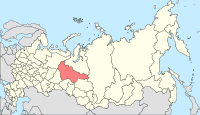This article should specify the language of its non-English content, using {{lang}}, {{transliteration}} for transliterated languages, and {{IPA}} for phonetic transcriptions, with an appropriate ISO 639 code. Wikipedia's multilingual support templates may also be used - notably kca for Khanty. (September 2024) |
 Khanty from the Ob river | |
| Total population | |
|---|---|
| 31,000[1] | |
| Regions with significant populations | |
| Khanty-Mansi Autonomous Okrug (Russia) | |
| 31,467 (2021)[2] | |
| 100 (2001)[3] | |
| Languages | |
| Khanty, Russian | |
| Religion | |
| Russian Orthodoxy, Shamanism | |
| Related ethnic groups | |
| Mansi | |



The Khanty (Khanty: ханти, romanized: hanti), also known in older literature as Ostyaks (Russian: остяки), are a Ugric Indigenous people, living in Khanty–Mansi Autonomous Okrug, a region historically known as "Yugra" in Russia, together with the Mansi. In the autonomous okrug, the Khanty and Mansi languages are given co-official status with Russian. In the 2021 Census,[4] 31,467 persons identified themselves as Khanty. Of those, 30,242 were resident in Tyumen Oblast, of whom 19,568 were living in Khanty-Mansi Autonomous Okrug and 9,985—in Yamalo-Nenets Autonomous Okrug. 495 were residents of neighbouring Tomsk Oblast, and 109 lived in Sverdlovsk Oblast.
- ^ "Итоги Всероссийской переписи населения 2020 года. Таблица 1. Национальный состав населения" [Results of the All-Russian population census 2020. Table 1. National composition of the population.]. rosstat.gov.ru. Retrieved 2023-01-03.
- ^ "Росстат — Всероссийская перепись населения 2020". rosstat.gov.ru. Retrieved 2023-01-03.
- ^ "National composition of population". Census (in Ukrainian). UA: State statistics committee of Ukraine. 2001.
- ^ "Национальный состав населения". Federal State Statistics Service. Retrieved 30 December 2022.